Parliament of India
| Parliament of India भारतीय संसद | |
|---|---|
|
| |
| Type | |
| Type | |
| Houses |
Rajya Sabha Lok Sabha |
| Leadership | |
| Structure | |
| Seats |
790 245 Members of Rajya Sabha 545 Members of Lok Sabha |
 | |
Rajya Sabha political groups |
NDA (majority) UPA |
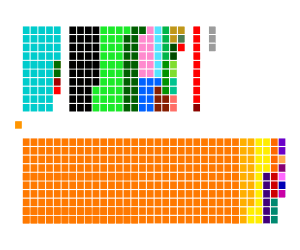 | |
Lok Sabha political groups |
NDA (majority) UPA |
| Elections | |
| Single transferable vote | |
| First past the post | |
Lok Sabha last election | Indian general election, 2014 |
| Meeting place | |
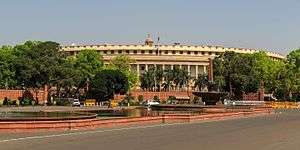 | |
| Sansad Bhavan, Sansad Marg, New Delhi, India | |
| Website | |
|
parliamentofindia | |
The Parliament of India is the supreme legislative body of the Republic of India. The Parliament is composed of the President of India and the houses. It is bicameral with two houses: Rajya Sabha (Council of States) and the Lok Sabha (House of the People). The President in his role as head of legislature has full powers to summon and prorogue either house of Parliament or to dissolve Lok Sabha. The president can exercise these powers only upon the advice of the Prime Minister and his Union Council of Ministers.
Those elected or nominated (by the President) to either house of Parliament are referred to as members of parliament (MP). The Member of Parliament, Lok Sabha are directly elected by the Indian public voting in Single-member districts and the Member of Parliament, Rajya Sabha are elected by the members of all the State Legislative Assembly by proportional representation. The Parliament has a sanctioned strength of 545 in Lok Sabha including the 2 nominees from the Anglo-Indian Community by the president and 245 in Rajya Sabha including the 12 nominees from the expertise of different fields of science, culture, art and history. The Parliament meets at Sansad Bhavan in New Delhi.
History
Parliament House
The Sansad Bhavan (Parliament House) is located in New Delhi. It was designed by Edwin Lutyens and Herbert Baker, who were responsible for planning and construction of New Delhi. The construction of buildings took six years and the opening ceremony was performed on 18 January 1927 by the then Governor-General of India, Irwin. The construction costs for the building were ₹8.3 million (US$120,000). The parliament is 570 feet (170 m) in diameter and covers an area of 6 acres (2.4 ha). The Central hall consists of the chambers of Lok sabha, Rajya Sabha and the Library hall. Surrounding these three chambers is the four storied circular structure providing accommodations for members and houses Parliamentary committees, offices and the ministry of Parliamentary affairs.[9]
Proposal for a new building
A new Parliament building may replace the existing complex. The new building is being considered on account of the stability concerns regarding the current complex.[10] A committee to suggest alternatives to the current building has been set up by the Ex. Speaker, Mira Kumar. The present building, an 85-year-old structure suffers from inadequacy of space to house members and their staff and is thought to suffer from structural issues. The building also needs to be protected because of its heritage tag.[11]
Composition
The Indian Parliament consists of two houses called the Lok Sabha and the Rajya Sabha with the President of India acting as their head.
President of India
The President of India, the Head of state are a component of Parliament. Under Article 60 and Article 111, President's responsibility is to scrutinise that bills/laws passed by the parliament are in accordance with constitutional mandate and stipulated procedure is followed before according his/her approval to the bills. The President of India is elected by the members of the Parliament of India and the state legislatures and serves for a term of five years.[12]
Lok Sabha
Lok Sabha (House of the People) or the lower house has members from 545 representing parliamentary constituencies across the country. 543 members are directly elected by citizens of India on the basis of universal adult franchise and two are appointed by the President of India. Every citizen of India who is over 18 years of age, irrespective of gender, caste, religion or race, who is otherwise not disqualified, is eligible to vote for the lok sabha.The Constitution provides that the maximum strength of the House be 552 members. It has a term of five years. To be eligible for membership in the Lok Sabha, a person must be a citizen of India and must be 25 years of age or older, mentally sound, should not be bankrupt and should not be criminally convicted. The total elective membership is distributed among the States in such a way that the ratio between the number of seats allotted to each State and the population of the State is, so far as practicable, the same for all States.[13]
Rajya Sabha
The Rajya Sabha (Council of States) or the upper house is a permanent body not subject to dissolution. One third of the members retire every second year, being replaced by newly elected members. Each member is elected for a term of six years.[14] Its members are indirectly elected by members of legislative bodies of the states. The Rajya Sabha can have a maximum of 250 members. It currently has a sanctioned strength of 245 with 233 members are to be elected from States and Union Territories (SUT) and 12 are nominated by the President of India. The number of members from a state depends on the population of the state. The minimum age for a person to become a member of Rajya Sabha is 30 years.
Session of parliament
The period during which the House meets to conduct its business is called a session. The Constitution empowers the president to summon each House at such intervals that there should not be more than a six-month gap between the two sessions. Hence the Parliament must meet at least twice a year. In India, the parliament conducts three sessions each year:[15]
- Budget session: February to May
- Monsoon session: July to September
- Winter session: November to December
Lawmaking procedures
Legislative proposals are brought before either house of the Parliament in the form of a bill. A bill is the draft of a legislative proposal, which, when passed by both houses of Parliament and assented to by the President, becomes an Act of Parliament. Money bills must originate in the Lok Sabha. The council of states can only make recommendations over the bills to the House, within a period of fourteen days.[16]
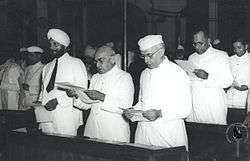

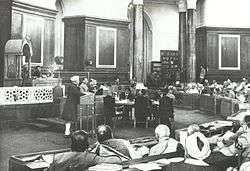

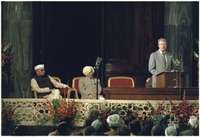

Parliamentary committees
Parliamentary committees are formed to deliberate specific matters at length. The public is directly or indirectly associated and studies are conducted to help committees arrive at the conclusions. Parliamentary committees are of two kinds: ad hoc committees and the standing committees.[17][18][19]
Standing committees are permanent committees constituted from time to time in pursuance of the provisions of an act of Parliament or rules of procedure and conduct of business in Parliament. The work of these committees is of a continuing nature. Adhoc committees are appointed for a specific purpose and they cease to exist when they finish the task assigned to them and submit a report.
Incidents
On 13 December 2001, Indian Parliament was attacked by a terrorist organisation. The perpetrators were Lashkar-e-Taiba (Let) and Jaish-e-Mohammed (JeM) terrorists. The attack led to the deaths of five terrorists, six Delhi Police personnel, two Parliament Security Services personnel and a gardener, which totalled 14 fatalities. It also led to increased tensions between India and Pakistan, resulting in the 2001-2002 India-Pakistan standoff.[20]
Parliament Session and debates
On 16 November 2016, The winter session of Indian Parliament had started and during the sittings in both Upper and Lower Houses of Parliament, observed strong opposition, and uproar by political parties, on note ban initiative by Narendra Modi Government on 8 November 2016.
See also
References
- ↑ Gupta, Smita (25 July 2012). "Pranab Mukherjee sworn-in 13th President". The Hindu. Chennai, India.
- ↑ "Chairman, Rajya Sabha, Parliament of India". rajyasabha.nic.in. Retrieved 19 August 2011.
- ↑ "P.J. Kurien is Rajya Sabha Deputy Chairman". The Hindu. Retrieved 25 February 2016.
- ↑ "Deputy Chairman, Rajya Sabha, Parliament of India".
- ↑ "Sumitra Mahajan elected speaker". Times of India. Retrieved 25 February 2016.
- ↑ "M Thambidurai elected deputy speaker of Lok Sabha". Times of India. 13 August 2014. Retrieved 14 August 2014.
- ↑ "Narendra Modi is sworn in as the 15th Prime Minister of India". The Times of India. 26 May 2014. Retrieved 15 August 2014.
- ↑ "PIB Press Releases". Pib.nic.in. Retrieved 25 October 2012.
- ↑ "History of the Parliament of Delhi". delhiassembly.nic.in. Retrieved 13 December 2013.
- ↑ "Delhi may see a new Parliament building". timesofindia.indiatimes.com. 13 July 2012. Retrieved 13 December 2013.
- ↑ Firstpost (2012-07-13). "Speaker sets up panel to suggest new home for Parliament". Firstpost. Retrieved 2012-08-15.
- ↑ Constitution of India (PDF). Ministry of Law and Justice, Government of India. 1 December 2007. p. 26. Retrieved 27 May 2013.
- ↑ "Lok Sabha". parliamentofindia.nic.in. Retrieved 19 August 2011.
- ↑ "Parliament – Government: National Portal of India". Home: National Portal of India. Retrieved 10 May 2011.
- ↑ "Our Parliament". New Delhi: Lok Sabha Secretariat. Archived from the original (PDF) on 6 September 2012. Retrieved 6 September 2012.
- ↑ "How bill becomes act". parliamentofindia.nic.in. Retrieved 8 May 2015.
- ↑ Parliamentary Committee. "Parliament of India". Indian Parliament.
- ↑ Committees of Rajya Sabha. "General Information". Rajya Sabha Secretariat.
- ↑ Lok Sabha - Committee Home. "Introduction". Lok Sabha Secretariat.
- ↑ "Terrorists attack Parliament; five intruders, six cops killed". rediff.com. 13 December 2001. Retrieved 13 December 2013.
Further reading
- "The Parliamentary System" by Arun Shourie, Publisher: Rupa & Co
External links
-
 Media related to Parliament of India at Wikimedia Commons
Media related to Parliament of India at Wikimedia Commons
